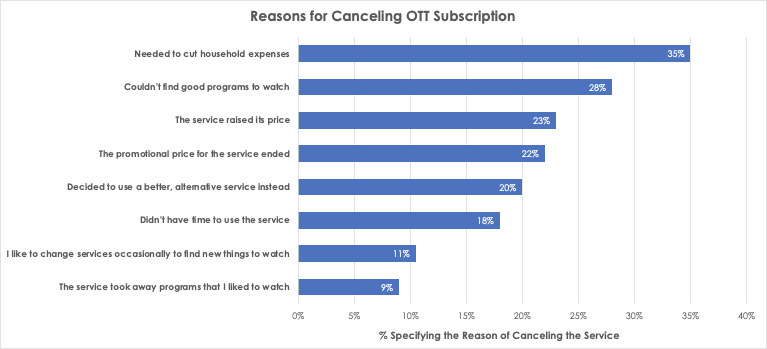It’s been over half a decade since House of Cards was first released on Netflix, the first foray into original programming for streaming media and content giants. Since that first binge-worthy drama premiered, the ubiquity of OTT streaming services such as HBO GO, Hulu, and Disney+ has altered the way in which content is consumed and has changed consumer behavior forever. As one might predict, competition for the attention of consumers—and thereby their share of wallet—continues to intensify.
The Challenge
The streaming media space is an over-saturated marketplace for brands and providers to play in. According to the Digital media trends survey, 13th edition, consumers have more than 300 streaming video services to choose from, with an average of 3 subscriptions per household; they found that “consumers are trying and buying a variety of streaming services”, and that “given the intense competition for viewers, consumers can usually find what they want to watch for what they’re willing to pay…”. So, how do we prevent or discourage a user from leaving our service and going to another (either from a content OR subscription perspective)? First, it might be helpful to understand why a user might leave.
A recent study involving streaming media brands and providers cite a multitude of reasons for consumers choosing to leave a service, including everything from content to economic factors. See figure 1, below:

With an average of three streaming services, it’s no surprise that users look to cut streaming first, especially considering outside economic factors such as rising home prices and “essential” living expenses. There’s only so much you can do to combat that statistic. PWC noted that there’s “… a general expectation that current services will continue to increase their prices, yet 33% of consumers expect to invest more in new services that are launching this coming year, and 21% are willing to pay more to gain access to ad-free content”—users aren’t going to completely cut streaming out of their life.
If we can’t control economic factors, let’s focus on what we can actively combat:
- Content and Discovery
- User Experience and
- Subscription Management
As media companies and brands continue to battle over consumers’ attention, McKinsey notes that “the next stage for the industry will lie in an intense focus on direct-to-consumer engagement.” It is the best way for media companies to sustain strong relationships with consumers, prevent competitors from diverting them, and win back the disengaged by tailoring offers to evolving preferences. That’s where MessageGears comes in.
At MessageGears, we’re dedicated to driving relevant user interactions and engagement that reduces churn and delivers high-value outcomes for OTT providers. As we look to address our three categorical reasons for churn above, we must look at them through the user lifecycle, and then design strategies and engagement programs to combat them with real-time, relevant touchpoints. Here are some strategies your brand can follow to combat churn.
Content and Discovery
There will never be a replacement for good content. Deloitte notes that “the primary reasons consumers choose a particular streaming video service is access: to watch shows and movies they can’t get anywhere else”. Where MessageGears plays a part is supporting you in designing your [content] strategy with your target segments in mind, and then ensuring those segments are able to locate and consume that content. MessageGears’ highly-targeted approach to real-time relevance intakes every data point about a user’s content preferences and viewing history, and then allows you to dynamically recommend and serve up content that will be of interest to them through a banner, full-page takeover, or interstitial. Make it easy to serve and showcase the content you already have.
The User Experience
We’ve just seen that good content is key to the streaming experience, however, it can be overwhelming for a user and with such a deconstructed TV experience, it’s key that your experience is a clean one. Ease of use and reliability are linked to the depth of engagement and are essential for driving retention and preference among video services. With MessageGears, you can support that experience in a number of ways, including a custom onboarding highlighting the key functionality, or a new user journey encouraging feature adoption and discovery. Additionally, MessageGears powers native UX/UI testing which can allow you to test different layouts and user experiences with different customers and optimize against those results.
Pricing & Subscription Management
As commonly cited reasons for OTT churn are pricing and subscription management issues. One common reason for churn is lapsing payments on trial periods where customers don’t add a recurring payment source – inciting churn. A current leading streaming service and MessageGears customer combats this by offering proactive, personalized messaging for users to update their payment methods before the end of the month. Being proactive in your messaging around subscriptions, trials and user preferences, delivered at the right time, can dramatically reduce a poor customer experience and ultimately, churn.
When real-time relevance and timeliness act in concert, they deliver a highly relevant, highly engaging and highly valuable experience to the user that will decrease the probability of churn.
Key Takeaways
- The key marketplace factors and trends driving OTT service engagement and customer churn
- Strategies to increase engagement in the video consumer journey: initial interaction before subscribing or viewing of the service starts, when a free trial or promotional period ends, after a popular series ends, and during a long period of customer inactivity
- Best practices of customer engagement strategies




